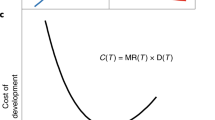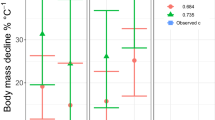Abstract
Body size and temperature are the two most important variables affecting nearly all biological rates and times1,2,3,4,5,6,7. The relationship of size and temperature to development is of particular interest, because during ontogeny size changes and temperature often varies8,9,10,11,12. Here we derive a general model, based on first principles of allometry and biochemical kinetics, that predicts the time of ontogenetic development as a function of body mass and temperature. The model fits embryonic development times spanning a wide range of egg sizes and incubation temperatures for birds and aquatic ectotherms (fish, amphibians, aquatic insects and zooplankton). The model also describes nearly 75% of the variation in post-embryonic development among a diverse sample of zooplankton. The remaining variation is partially explained by stoichiometry, specifically the whole-body carbon to phosphorus ratio. Development in other animals at other life stages is also described by this model. These results suggest a general definition of biological time that is approximately invariant and common to all organisms.
This is a preview of subscription content, access via your institution
Access options
Subscribe to this journal
Receive 51 print issues and online access
$199.00 per year
only $3.90 per issue
Buy this article
- Purchase on Springer Link
- Instant access to full article PDF
Prices may be subject to local taxes which are calculated during checkout





Similar content being viewed by others
References
Schmidt-Nielsen, K. Scaling: Why is Animal Size So Important? (Cambridge Univ. Press, Cambridge, 1983).
Calder, W. A. III Size, Function, and Life History (Harvard Univ. Press, Cambridge, Massachusetts, 1984).
Peters, R. H. The Ecological Implications of Body Size (Cambridge Univ. Press, Cambridge, 1983).
Calder, W. A. III in Avian Energetics (ed. Paynter, R. A.) 86–151 (Nutall Ornithology Club 15, Cambridge, 1974).
Lindstedt, S. L. & Calder, W. A. III Body size, physiological time, and longevity of homeothermic animals. Q. Rev. Biol. 56, 1–16 (1981).
Somero, G. S. in Handbook of Physiology Vol. 13 (ed. Dantzler, W. H.) 1391–1444 (Oxford Univ. Press, New York, 1997).
Cossins, A H. & Bowler, K. Temperature Biology of Animals (Chapman and Hall, London, 1987).
Gillooly, J. F. & Dodson, S. I. The relationship of neonate mass and incubation temperature to embryonic development time in a range of animal taxa. J. Zool. 251, 369–375 (2000).
Gillooly, J. F. & Dodson, S I. The relationship of egg size and incubation temperature to embryonic development time in univoltine and multivoltine aquatic insects. Freshwat. Biol. 44, 595–604 (2000).
Pauly, D. & Pullin, R. S. V. Hatching time in spherical, pelagic, marine fish eggs in response to temperature and egg size. Eviron. Biol. Fishes 22, 261–271 (1988).
Heinroth, O. Die beziehungen swischen vogelgewicht, eigewicht, gelegewicht und brutdauer. J. Ornithol. 70, 172–285 (1912).
Gillooly, J. F. Effect of body size and temperature on generation time in zooplankton. J. Plankt. Res. 22, 241–251 (2000).
West, G. B., Brown, J. H. & Enquist, B. J. A general model for the origin of allometric scaling laws in biology. Science 276, 122–126 (1997).
West, G. B., Brown, J. H. & Enquist, B. J. A general model for ontogenetic growth. Nature 413, 628–631 (2001).
Gillooly, J. F., Brown, J. H., West, G. B., Savage, V. M. & Charnov, E. L. Effects of size and temperature on metabolic rate. Science 293, 2248–2251 (2001).
Scott, W. B. & Scott, M. G. Atlantic fishes of Canada. Can. Bull. Fish. Aquat. Sci. 219 (1988).
Vetter, R. A. H. Ecophysiological studies on citrate-synthase: I: Enzyme regulation of selected crustaceans with regard to temperature adaptation. J. Comp. Physiol. B 165, 46–55 (1995).
Raven, J. A. & Geider, R. J. Temperature and algal growth. New Phytol. 110, 441–461 (1988).
McLeese, J. M. & Eales, J. G. 3,5,3′ Triiodo-L-thyroxine and L-thyroxine uptake into red blood cells of rainbow trout, Oncorhynchus mykiss. Gen. Comp. Endocrinol. 102, 47–55 (1965).
Elser, J. J., Dobberfuhl, D., MacKay, N. A. & Schampel, J. H. Organism size, life history and N:P stoichiometry: toward a unified view of cellular and ecosystem processes. Bioscience 46, 674–684 (1996).
Hessen, D. O. & Lyche, A. Inter- and intraspecific variations in zooplankton element composition. Arch. Hydrobiol. 121, 343–353 (1991).
Main, T. M., Dobberfuhl, D. R. & Elser, J. J. N:P stoichiometry and ontogeny of crustacean zooplankton: A test of the growth rate hypothesis. Limnol. Oceanogr. 42, 1474–1478 (1997).
Foran, J. A. A comparison of the life-history features of a temperate and a subtropical Daphnia species. Oikos 46, 185–193 (1986).
Hanazato, T. & Yasuno, M. Effect of temperature in the laboratory studies on growth, egg development and first parturition of five species of cladocera. Jpn. J. Limnol. 46, 185–191 (1985).
Andersen, D. H. & Benke, A. C. Growth and reproduction of the cladoceran Ceriodaphnia dubia from a forested floodplain swamp. Limnol. Oceanogr. 39, 1517–1527 (1994).
Kankaala, P. & Wulff, F. Experimental studies on temperature-dependent embryonic and postembryonic developmental rates of Bosmina longispina maritime (Cladocera) in the Baltic. Oikos 36, 137–146 (1981).
Maier, G. The effect of temperature on the development, reproduction, and longevity of two common cyclopoid copepods, Eucyclops serrulatus (Fischer) and Cyclops strennus (Fischer). Hydrobiologia 203, 165–175 (1990).
Munro, I. G. The effect of temperature on the development of egg, naupliar and copepodite stages of two species of copepods, Cyclops vicinus (Uljanin) and Eudiaptomus gracilis (Sars). Oecologia 16, 355–367 (1974).
Geiling, W. T. & Campbell, R. S. The effect of temperature on the development rate of the major life stages of Diaptomus pallidus (Herrick). Limnol. Oceanogr. 17, 304–307 (1972).
Andersen, T. & Hessen, D. O. Carbon, nitrogen, and phosphorus content of freshwater zooplankton. Limnol. Oceanogr. 36, 807–814 (1991).
Acknowledgements
We thank S. Dodson, M. Ernest, C. M. Del Rio, E. Toolson, T. Turner and B. Wolf for comments or discussions that improved this manuscript. J.F.G. thanks J. S. Gillooly for support and encouragement. J.F.G., G.B.W. and J.H.B. are grateful for the support of the Thaw Charitable Trust and a Packard Interdisciplinary Science Grant; V.M.S., G.B.W. and J.H.B. for the support of the National Science Foundation; and E.L.C. for the support received as a MacArthur Fellow. G.B.W. also thanks the Theoretical Physics Department at Oxford Unviersity for its hospitality, and the EPSRC for support.
Author information
Authors and Affiliations
Corresponding author
Rights and permissions
About this article
Cite this article
Gillooly, J., Charnov, E., West, G. et al. Effects of size and temperature on developmental time. Nature 417, 70–73 (2002). https://doi.org/10.1038/417070a
Received:
Accepted:
Issue Date:
DOI: https://doi.org/10.1038/417070a
This article is cited by
-
Larval precompetency and settlement behaviour in 25 Indo-Pacific coral species
Communications Biology (2024)
-
Fouling communities from the South African west coast are vulnerable to cooling and ocean acidification
Marine Biodiversity (2024)
-
The evolution of fast-growing coral reef fishes
Nature (2023)
-
Effects of projected end-of-century temperature on the muscle development of neonate epaulette sharks, Hemiscyllium ocellatum
Marine Biology (2023)
-
Growth and morphology of Critically Endangered green sawfish Pristis zijsron in globally important nursery habitats
Marine Biology (2023)
Comments
By submitting a comment you agree to abide by our Terms and Community Guidelines. If you find something abusive or that does not comply with our terms or guidelines please flag it as inappropriate.



